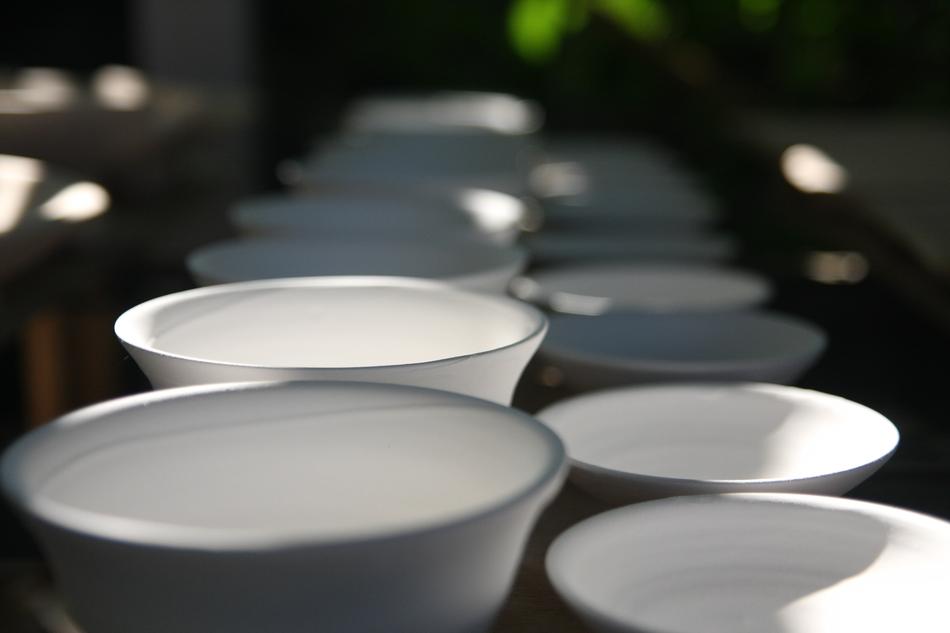Porcelain
Contents |
[edit] Introduction
Porcelain is a translucent, non-porous ceramic material. It is made by firing a mixture of kaolinite (a clay mineral present in kaolin), quartz and feldspar. Kaolinite is sometimes referred to as china clay or porcelain earth.
Hard porcelain is usually made from a mixture of 50% kaolinite, 25% quartz and 25% felspar. Soft porcelain is made from the same materials but with different proportions: 25% kaolinite, 45% quartz and 30% feldspar. Soft porcelain is generally less expensive to make because it is fired at lower temperatures.
[edit] Making porcelain
To make porcelain, kaolin is washed and screened to produce kaolinite. This is then mixed with finely ground quartz and felspar along with water, soda and other materials. Next, the substance is thoroughly kneaded and then it is moulded or cast into plaster moulds.
Once the moulds have dried, the material is placed in a kiln and fired at a temperature of approximately 900C. This produces a substance that is hard and water tight, but its surface is dull.
[edit] Glazing
To produce a glaze on the surface of the item, it is placed in a liquid of the same components, but this time the quartz and felspar are the dominant substances. The object is then placed in a kiln, where it is fired again at a temperature of about 1400C. In this heating treatment, which lasts from approximately 20 to 30 hours, the particles of the mixture become partially fused together to produce a continuous coating on the surface of the object.
Glazes can be painted with dyes to produce different colours or patterns. To make the substances melt and fuse, the painted objects are fired in an enamelling furnace to about 800C. The paint can also be applied before the glazing.
Porcelain is primarily known for its use in domestic applications, but it can also be used in laboratories and in industry as an insulating material. It is not degraded by liquids or gases, and it is somewhat unaffected by moderate variations in temperature.
[edit] Related articles on Designing Buildings Wiki
Featured articles and news
The UK's Modern Industrial Strategy: A 10 year plan
Previous consultation criticism, current key elements and general support with some persisting reservations.
Building Safety Regulator reforms
New roles, new staff and a new fast track service pave the way for a single construction regulator.
Architectural Technologist CPDs and Communications
CIAT CPD… and how you can do it!
Cooling centres and cool spaces
Managing extreme heat in cities by directing the public to places for heat stress relief and water sources.
Winter gardens: A brief history and warm variations
Extending the season with glass in different forms and terms.
Restoring Great Yarmouth's Winter Gardens
Transforming one of the least sustainable constructions imaginable.
Construction Skills Mission Board launch sector drive
Newly formed government and industry collaboration set strategy for recruiting an additional 100,000 construction workers a year.
New Architects Code comes into effect in September 2025
ARB Architects Code of Conduct and Practice available with ongoing consultation regarding guidance.
Welsh Skills Body (Medr) launches ambitious plan
The new skills body brings together funding and regulation of tertiary education and research for the devolved nation.
Paul Gandy FCIOB announced as next CIOB President
Former Tilbury Douglas CEO takes helm.
UK Infrastructure: A 10 Year Strategy. In brief with reactions
With the National Infrastructure and Service Transformation Authority (NISTA).
Ebenezer Howard: inventor of the garden city. Book review.
The Grenfell Tower fire, eight years on
A time to pause and reflect as Dubai tower block fire reported just before anniversary.
Airtightness Topic Guide BSRIA TG 27/2025
Explaining the basics of airtightness, what it is, why it's important, when it's required and how it's carried out.
Construction contract awards hit lowest point of 2025
Plummeting for second consecutive month, intensifying concerns for housing and infrastructure goals.
Understanding Mental Health in the Built Environment 2025
Examining the state of mental health in construction, shedding light on levels of stress, anxiety and depression.
The benefits of engaging with insulation manufacturers
When considering ground floor constructions.
Lighting Industry endorses Blueprint for Electrification
The Lighting Industry Association fully supports the ECA Blueprint as a timely, urgent call to action.
























